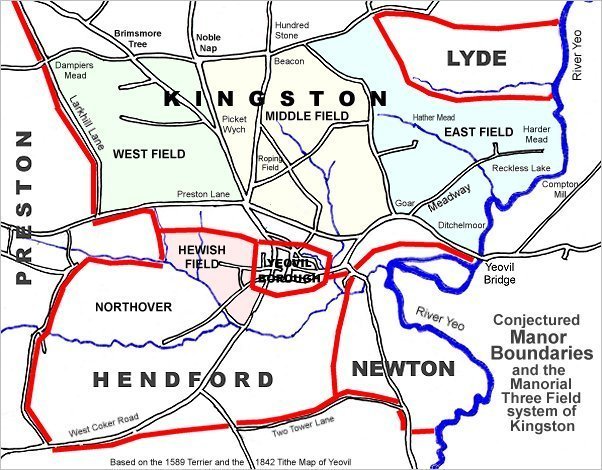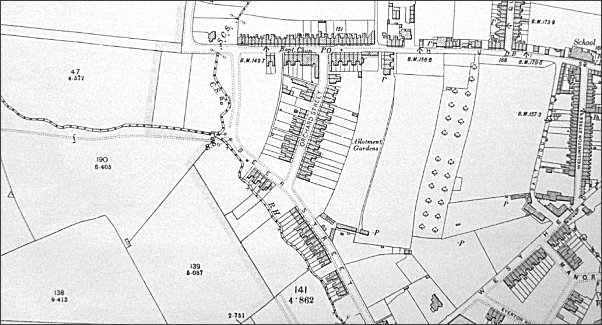Seward's Close
Seward's Close
Remnant of the medieval common field called Hewish Field
The great medieval field called Northover (see first map below) was later broken up and part of it became a large common field called Hewish, or Hewish Field, stretching from Ram Park in the north, the boundary with the parish of Preston Plucknett in the west, today's West Hendford in the south and roughly as far as today's Clarence Street in the east. The parcels comprising the former great common field called Hewish Field are shown shaded green in the 1842 Tithe Map below.
The name Huish, in its various spellings through time, derives from the Old English 'hiwisc' meaning a household.
On 1 July 1415 Thomas, Earl of Arundel, granted the advowson of Yeovil Rectory to Henry V with "two acres in the field called Huysh".
It was recorded that in 1611 St Leonard's Fair for rother cattle was held in "the field called Huishe in Hendford" - in this instance Hendford being the Manor of Hendford, not the road of that name. As a sidenote; the word 'rother' is an old Anglo-Saxon word for cattle. The rother cattle were long-horned, fleshy beasts prized for their meat, milk, hide and horn (see photo here).
An indenture of 1715 remarks on six acres of arable land "lying in a common field called Hewish in the tything of Hinford.... lately enclosed" - the words 'lately enclosed' being a good indication of when this common field began to be parcelled up. By the 1750s the division parcels of Hewish Field were more or less finalised as shown in the 1842 Tithe Map below.
One of these division parcels of the former common field was Seward's Close (Parcel 610). The 1846 Tithe Apportionment noted that Seward's Close was part of the extensive land holdings owned by Rev. James Hoper and the tenant, as with almost all of Hooper's holdings was William Buck. Seward's Close was recorded as pasture for grazing livestock and measured 1a 3r 20p.
Seward's Close was bounded on the north by the field access track known as Hewish Lane (today's Huish), to the west by the small brook marking the boundary with the parish of Preston Plucknett, to the south by Higher Blacklands (Parcel 612 - also owned by Hooper and occupied by Buck) and to the east by Daniell's Orchard (Parcel 609) and Priddle's Mead (Parcel 611).
Today the former Seward's Close is covered with the houses and gardens of West Street, built after 1901 by local businessman, town councillor and local 'character' Levi Beer. West Street appears on the 1901 Ordnance Survey (shown below) as a dotted line running across Seward's Close indicating that it was either proposed or under construction t that time.
For details on historic land measurement (ie acres, roods and perches) click here.
maps

This map, based on the descriptions in the 1589 Terrier and the 1846 Tithe Map of Yeovil shows the approximate boundaries of the Manors of Kingston and Hendford as well as the manorial three-field system used in Kingston.

This map is based on the 1842 Tithe Map with field names added from the 1846 Tithe Award. The area shaded light green was originally a large common field called Hewish Field that had been formed out of the earlier medieval field called Northover. By the time of the 1842 Tithe Map, shown here, Hewish Field had been further sub-divided into many parcels as shown.
Seward's Close is left of centre.

The 1842 Tithe Map superimposed (roughly) over a modern street map showing where several modern roads, for example the rear gardens of the eastern side of Grove Avenue, follow former field boundaries.

The 1901 Ordnance Survey showing Beer Street running from its junction with Huish at top to West Hendford, just off the bottom of the map. That part which is today's West Street was simply at the planning stage and is shown as a dotted line running across Seward's Close.
Gallery

Built on Seward's Close, West Street seen from the junction with Huish in the mid-1960s. The street has probably not been this free of parked cars since! During the Second World War an ARP warden's post for twenty four wardens, designated as Post R, was located on the ground behind the hedge at right.

This photograph was taken at the same time as the one above but from West Street looking back towards Huish. The houses here were built in 1906. At extreme left is the brook that marked the boundary with the parish of Preston Plucknett.